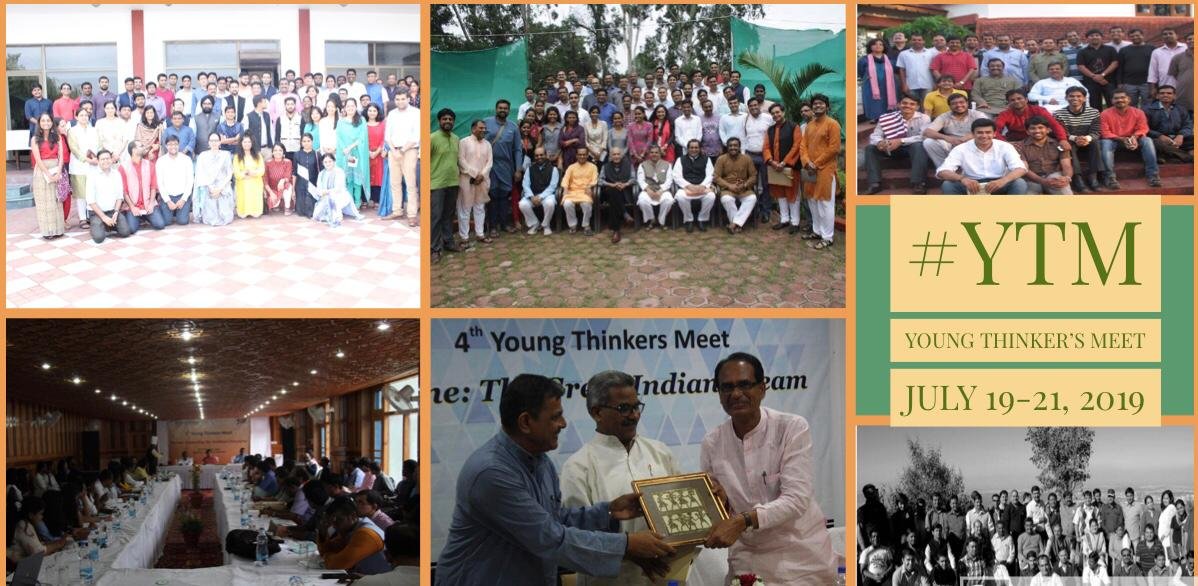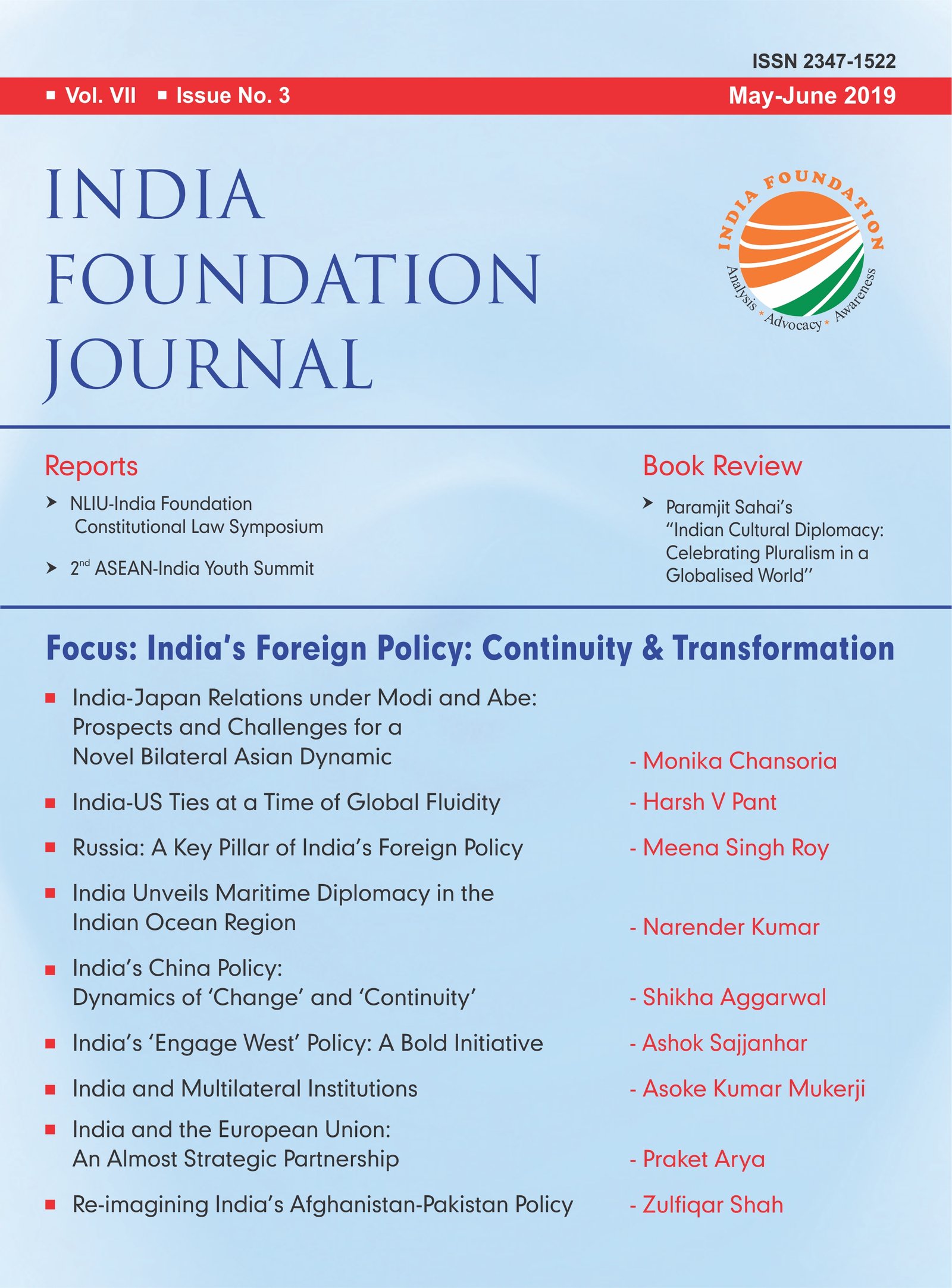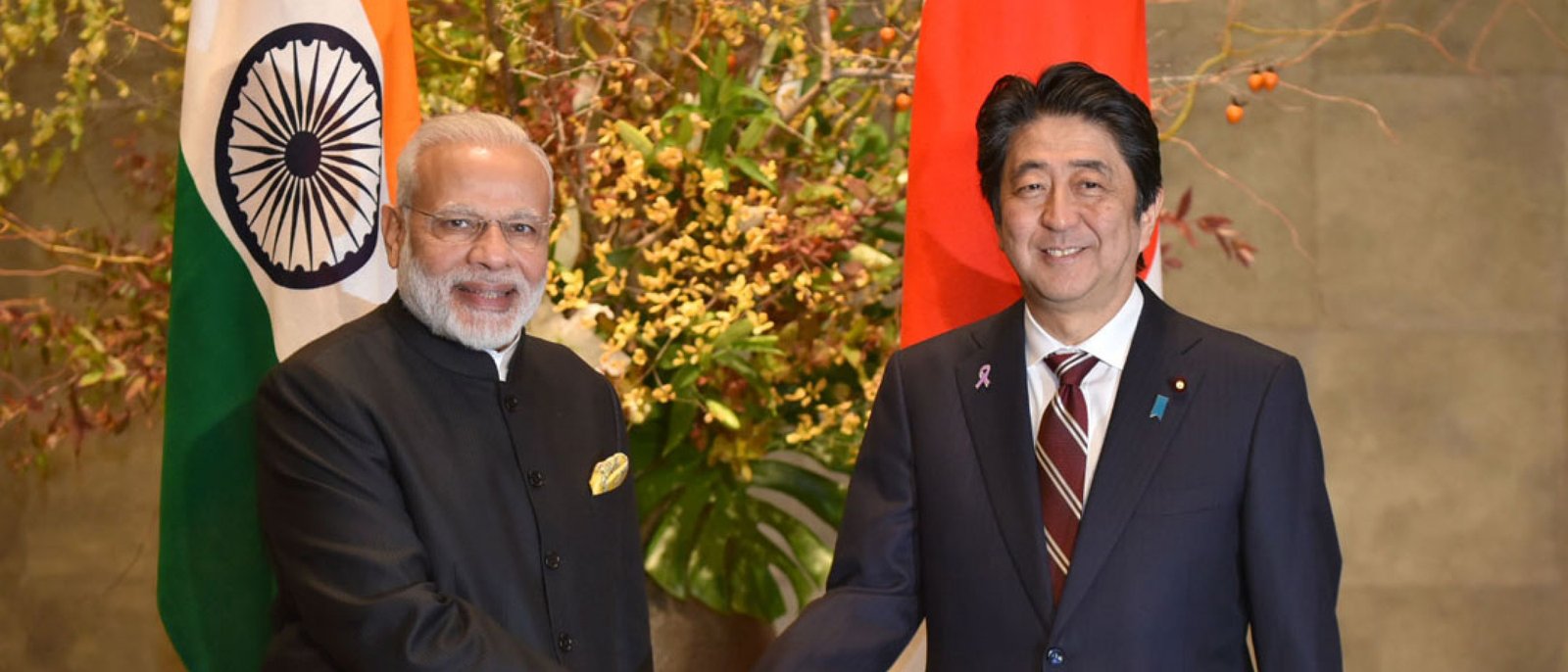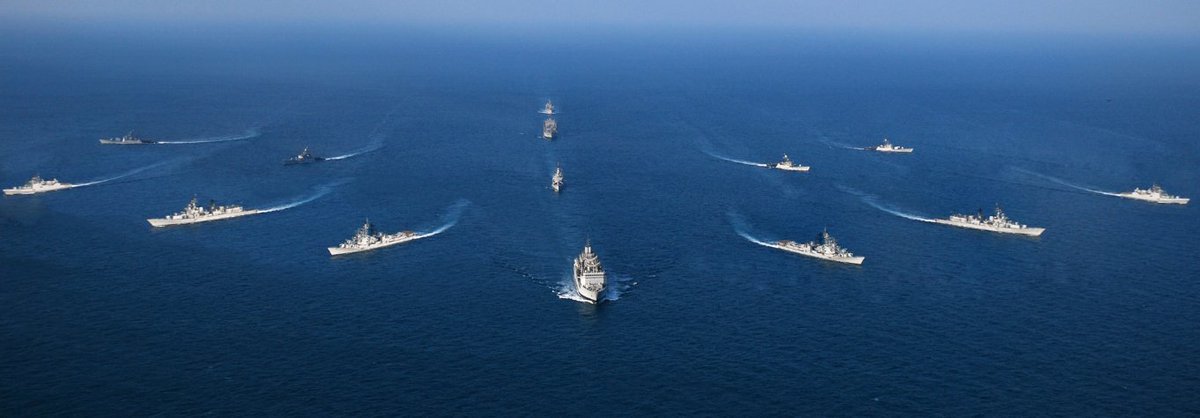The general elections in India in 2014 coincided with the ambitious negotiation of a global agenda for sustainable development at the United Nations (UN). These negotiations converged the three aspects of sustainable development – economic, social and environmental. The outcome, adopted by world leaders in September 2015, was Agenda 2030 for Sustainable Development, with 17 Sustainable Development Goals (SDGs) at its core. This has been a major success for multilateral diplomacy.1
The principle of international cooperation is the core of multilateralism. As an “original” founder-member of the multilateral system created by the UN, India has major stakes in effective international cooperation. With over 40% of her Gross Domestic Product (GDP) being contributed by her international trade,2 India’s destiny is closely linked with sustaining international cooperation to catalyze her transformation into a major power. India’s ability to participate on an equal basis in the decisions of multilateral institutions is intrinsic to this endeavor.
Agenda 2030 has validated India’s view that the eradication of poverty is central to sustainable development.3 Home to almost 270 million people living under the poverty line,4 India has a strong interest in implementing Agenda 2030 on the basis of her nationally set priorities and transform herself. Globally agreed means of implementing Agenda 2030 include supportive financial flows, such as Foreign Direct Investment (FDI) for employment and infrastructure, as well as access to appropriate technologies and clean energy to accelerate development while protecting the environment.
In the run-up to the May 2014 general elections in India, several of these priorities assumed political prominence. The new government’s focus on prioritizing inclusive development, captured in the SabkaSaath, Sabka Vikas slogan, galvanized voters in India as well as interlocutors from many of India’s strategic partners.5
India’s clear road-map of national targets for development announced by the government between May 2014 and September 2015 served to significantly align India’s national development agenda with the goals formulated by the UN.SabkaSaath, Sabka Vikas became aligned with SDG 1, the over-reaching goal for poverty eradication. The National Food Security Mission aligned with SDG 2 for food security; Health Insurance schemes with SDG 3 for good health and well-being; the National Education Mission with SDG 4 for quality education; BetiBachaoBetiPadhao with SDG 5 on gender equality; Swachh Bharat with SDG 6 for sanitation and clean water; the target of 175 GW of renewable energy by 2022 with SDG 7 on clean energy; the MNREGA scheme and Skill India with SDG 8 on decent work for all; Make in India, Start Up India and Digital India with SDG 9 on industry, innovation and infrastructure; Jan DhanYojna with SDG 10 to reduce inequalities; the Smart Cities Mission with SDG 11 for sustainable cities and communities, India’s SAGAR policy announced in March 2015 with a focus on the Blue Economy with SDG 14 on oceans; and the Krishi Vikas and FasalBimaYojna with SDG 15 on agriculture and life on land.
Prime Minister Modi’s first official visit to the UN General Assembly (UNGA) on 27 September 2014 reiterated India’s commitment to multilateralism. He said that “India is a country that constitutes one-sixth of humanity; a nation experiencing economic and social transformation on a scale rarely seen in history. Every nation’s world view is shaped by its civilization and philosophical tradition. India`s ancient wisdom sees the world as one family. It is reflected in a tradition of openness and diversity; co-existence and cooperation. This is why India speaks not just for itself, but also for the cause of justice, dignity, opportunity and prosperity around the world. It is also because of this timeless current of thought that India has an unwavering belief in multilateralism.”6
The 2014 UNGA address by the Prime Minister contained his proposal for the UN to declare an International Yoga Day. Emphasizing international cooperation to recognize the integral bond between humanity and the environment, the proposal captured the imagination of delegations in the UN General Assembly. As the Prime Minister explained, “For us in India, respect for nature is an integral part of spiritualism. We treat nature’s bounties as sacred. Yoga is an invaluable gift of our ancient tradition. Yoga embodies unity of mind and body; thought and action; restraint and fulfillment; harmony between man and nature; a holistic approach to health and well-being. It is not about exercise but to discover the sense of oneness with yourself, the world and the nature. By changing our lifestyle and creating consciousness, it can help us deal with climate change. Let us work towards adopting an International Yoga Day.”7
The implementation of this proposal was swift, demonstrating the commitment of member-states to making a living reality out of international cooperation. Within 75 days, 176 other countries joined India in co-sponsoring a UNGA resolution on 11 December 2014 to declare 21 June every year as the International Day of Yoga. This has become a record for such resolutions in the UNGA. When the International Yoga Day began to be implemented from 2015 onwards, its link with SDG 3 (global health) and SDG 12 (changing lifestyles for responsible consumption and production) of Agenda 2030 became explicit. As the Prime Minister had said in his address, “We can achieve the same level of development, prosperity and well-being without necessarily going down the path of reckless consumption.”8
At the Paris meeting of the UN Framework Convention on Climate Change (UNFCC) in November 2015, India took a major initiative to push environmental issues towards the path of meaningful international cooperation rather than polemical confrontation. Together with President Francois Hollande of France, Prime Minister Modi launched an International Solar Alliance (ISA). Speaking on the occasion, he said, “Our hope for a sustainable planet rests on a bold global initiative. It will mean advanced countries leaving enough carbon space for developing countries to grow. That is natural climate justice. It also means a growth path with lighter carbon footprint. So, convergence between economy, ecology and energy should define our future.”9
In March 2018, barely 16 months after having proposed the ISA, Prime Minister Modi jointly inaugurated the ISA with visiting French President Emmanuel Macron in India. In October 2018, India hosted the first General Assembly of the ISA, which became the first inter-governmental organization associated with the UN to be headquartered in India since India’s independence in August 1947.10 Aligning India firmly with SDG 7 of Agenda 2030 on clean energy, the Prime Minister asserted that India was doing so with a new self-confidence of “Poverty to Power.”11
Such positive contributions to implementing the principle of international cooperation by India are today being increasingly challenged by major powers seeking to impose their domestic political and economic policies on the multilateral system.12 Unilateral measures, including attempts to enforce extra-territorial application of domestic laws, directly impacts on the capacity of countries like India to meet their national developmental targets under Agenda 2030. Polarization between the major powers has begun to create frictions within multilateral institutions established under the UN framework.13 These include the International Monetary Fund (IMF), World Bank and the World Trade Organization (WTO). The agreements in 2010 to reform decision-making within the IMF and World Bank to reflect global economic realities are yet to be implemented,14 mainly on account of the reluctance of western economies to cede their inherited privileges in decision-making in multilateral financial institutions.15
In the WTO, the United States is targeting the effective functioning of the international dispute settlement mechanism which it helped create in 1995, and which has adjudicated over 500 trade disputes between member-states so far. Attempts to revert to the pre-WTO bilateral approach to use punitive measures based on domestic laws to resolve trade disputes jeopardizes international cooperation based on the international rule of law.16
India’s ability to make multilateral institutions responsive to priorities of developing countries depends on India’s participation as an equal member in decision-making in all structures of multilateral governance. It is worth recalling that Agenda 2030, in which India participated actively, was adopted unanimously by the UN General Assembly, which takes decisions on the democratic principle of one-country one-vote.17 When adopting Agenda 2030, world leaders had unanimously stressed that “there can be no sustainable development without peace and no peace without sustainable development.”18
The mandate to ensure international peace and security is the “primary responsibility” of the UN Security Council according to the UN Charter.19 Unlike in the UN General Assembly, decision-making in the UN Security Council is determined by the veto power of the five self-selected permanent members (China, France, Russia, the UK and the USA).20
This is the context for India’s active leadership in the UN General Assembly since November 197921 to reform the UN Security Council by amending the UN Charter, including the veto provision in decision-making.
Since 2014, India has attempted to conclude this reform within a fixed time-frame. Prime Minister Modi exhorted fellow world leaders in 2014 to “reform the United Nations, including the Security Council, and make it more democratic and participative. Institutions that reflect the imperatives of 20th century would not be effective in the 21st. It would face the risk of irrelevance; and we will face the risk of continuing turbulence with no one capable of addressing it.”22 China is leading the push-back by permanent members against reforming the Security Council.
What are the issues concerning India on the agenda of the Security Council which need India’s participation on an equal basis in the Council’s decision-making process? Countering terrorism directed against India by Pakistan is a priority. Before the Security Council became active in seeking to counter terrorism through its resolutions,23 which are binding on all member-states of the UN under Article 25 of the UN Charter, India had taken the lead in using the UN General Assembly to compel member-states to prosecute or extradite terrorists wanted for committing terrorist attacks against India. Speaking at the UN General Assembly in 2014, Prime Minister Modi urged world leaders to “put aside our differences and mount a concerted international effort to combat terrorism and extremism. As a symbol of this effort, I urge you to adopt the Comprehensive Convention on International Terrorism (CCIT).”24 The CCIT contains the legal obligation of “prosecute or extradite”. Pakistan has delayed consideration of the CCIT in the UN General Assembly’s Legal Committee (of which it was Vice-Chair in 2016-2017)25.
After the Pathankot terror attack of 2016, India’s request to the Security Council to list the leader of the Jaish-e-Mohammed (JeM) Masood Azhar on the Sanctions List26 has been repeatedly blocked by China, a veto-wielding permanent member. Earlier, following the 26 November 2008 terrorist attacks on Mumbai, carried out by the Lashkar-e-Toiba (LeT), the UN Security Council had placed the leaders of the LeT like Hafiz Saeed and Zaki-ur-Rehman Lakhvi on its Sanctions List on 10 December 2008.27 However, the Security Council has been unable to enforce its decision to imposing sanctions on Hafiz Saeed so far,28 due to lack of political will among its permanent members.
Related to this is the impact of terrorism on UN peacekeeping operations (PKOs). Out of the 71 UN PKOs mandated by the UN Security Council since 1948, India has participated in 49, contributing over 200,000 troops to date.29 Terrorism has already targeted PKOs like UNDOF30 in the Golan Heights and MINUSMA31 in Mali. The potential for an increase in terrorist attacks on other UN missions, including UNAMA in Afghanistan, has become greater due to the perception that the Security Council is ineffective in countering terrorism, including terrorist acts against the UN itself.
This aggravates the existing shortcomings in Security Council in the effective use of PKOs for conflict resolution. Currently, as many as 75,000 out of the total of about 100,000 UN peacekeeping troops are deployed by the Security Council to respond to just 4 conflicts in Africa,32 which continue to spiral out of control. Two reasons for this failure are lack of representation among the Council’s permanent members from Africa; and the absence of consultations by the Security Council with troop-contributing countries like India, which are not permanently represented in the Council. Under Article 44 of the UN Charter, India has the right to seek consultations with the Security Council on deployment of its troops contributed to PKOs. Prime Minister Modi had drawn attention to this issue, emphasizing that “the problems arise to a large extent because Troop Contributing Countries do not have a role in the decision-making process.”33
Despite deployment of PKOs, the Security Council has not been able to contain escalating crises across the continents, which extract a huge human and material cost. More than 68 million people are currently displaced by violent conflicts. Till 2018, over 3800 UN peacekeepers, including 169 Indian UN troops, have laid down their lives to uphold the UN Charter. At the Leaders’ Summit on Peacekeeping in New York in September 2015, Prime Minister Modi had underlined that “it would be most fitting if the proposed memorial wall to the fallen peacekeepers is created quickly. India stands ready to contribute, including financially, to this objective.”
Beyond measures to counter terrorism and the deployment of PKOs, other issues on the Council’s agenda impacting on India’s strategic interests include the situation in Yemen, which sits astride the main sea lane of communication through the Red Sea that carries the bulk of India’s international trade; the situation in Iran, which is an important source of energy for India, as well as a critical partner in India’s connectivity projects like the International North-South Transport Corridor through Bandar Abbas and the Chabahar Project; the situation in Afghanistan, especially regarding attempts to regularize the re-integration of the Taliban into Afghanistan’s political structures; and the looming confrontation between the major powers on securitizing cyber space and outer space, where India is an emerging power.
As India looks to contribute to strengthen the multilateral system, two areas emerge as priorities for her.
First, India must become an equal participant in Security Council decision-making to ensure that this multilateral structure is responsive to India’s core interests of ensuring peace and security for sustainable development. To amend the UN Charter and reform the UN Security Council, a UN General Assembly resolution needs to be adopted. China has asserted that such a resolution requires “comprehensive consensus”.34 China’s assertion flies in the face of the fact that the UN General Assembly decided unanimously in 1998 that any resolution for deciding on Security Council reform needs only a two-thirds majority,35 and not “comprehensive consensus.” India must take the lead to counter China’s blocking tactic in the UN General Assembly by tabling the text of a draft resolution on Security Council reform co-sponsored by at least 129 member-states (a two-thirds majority).
Second, India must take the initiative to restore the primacy of the principle of international cooperation, on which the current multilateral system was founded a century ago. In 1963, over half a century ago, the UN General Assembly36 had declared 1965, the 20th anniversary of the United Nations, as the “International Co-operation Year”.
Given India’s significant stakes in effective international cooperation for the transformation of India, an Indian initiative in the UN General Assembly to declare the 75th anniversary year of the founding of the UN in 2020, as a Year of International Cooperation would galvanize the latent sentiment among the majority of UN member-states for restoring the inter-linkages between peace, security, human rights and sustainable development. In addition, such a contribution by India for making multilateralism relevant for the 21st century would create an important leadership framework for India when she assumes the Chair of the G-20 in 2022.
(Shri Asoke Kumar Mukerji retired after over 37 years in the Indian Foreign Service as Permanent Representative of India to the United Nations in December 2015. He led the team that implemented Prime Minister Narendra Modi’s proposal for the UN General Assembly to declare an International Yoga Day in 2014, in a record time of 75 days with 177 co-sponsoring countries. He led India’s negotiations on Agenda 2030 on Sustainable Development which was adopted by world leaders in September 2015. In July 2018, the University of East Anglia (UK) awarded him a Doctor of Civil Laws (honoris causa) degree for his contributions to diplomacy.)
References:
1 United Nations, “Transforming our world: The Agenda 2030 for Sustainable Development”, Preamble, 25 September 2015. Agenda 2030 was adopted at the UN Summit in New York attended by Prime Minister Narendra Modi. Accessed at https://sustainabledevelopment.un.org/post2015/transformingourworld
2 World Integrated Trade Solution (WITS), The World Bank and UNCTAD, “India Trade Statistics”. Accessed at https://wits.worldbank.org/CountryProfile/en/IND
3 In 1972, at the first UN Conference on the Human Environment held in Stockholm, India’s statement “poverty is the biggest polluter” had drawn strong criticism from environmental activists, who saw it as an attempt by India and other developing countries to shirk their obligations to protect the environment in the pursuit of accelerated socio-economic development.
4 The World Bank, “India’s Poverty Profile” Snapshot 2012, May 27, 2016. Accessed at http://www.worldbank.org/en/news/infographic/2016/05/27/india-s-poverty-profile
5 U.S. Department of State, “Remarks at the Center for American Progress India:2020 Program”, Secretary of State John Kerry, 28 July 2014. Accessed at https://2009-2017.state.gov/secretary/remarks/2014/07/229870.htm
6 Narendra Modi, “Text of the PM’s Statement at the UN General Assembly”, 27 September 2014. Accessed at https://www.narendramodi.in/text-of-the-pms-statement-at-the-united-nations-general-assembly-6660
7 Ibid.
8 Ibid.
9 Narendra Modi, “Let us turn to the Sun to power our future”, Launch of International Solar Alliance, Paris, 30 November 2015. Accessed at https://www.narendramodi.in/pm-modi-at-the-launch-of-international-solar-alliance-385253
10 Press Information Bureau, Government of India. “PM inaugurates first Assembly of International Solar Alliance”, 2 October 2018. Accessed at http://pib.nic.in/newsite/PrintRelease.aspx?relid=183908
11 Narendra Modi, “PM inaugurates first assembly of the International Solar Alliance”, 2 October 2018. Accessed at https://www.narendramodi.in/pm-modi-inaugurates-first-assembly-of-international-solar-alliance-541716
12 Both the “America First” policy of the United States and the “Belt and Road Initiative” (BRI) of China impact on multilateralism today, the former by weakening the rules-based system of multilateral structures and the latter by distorting multilateral structures to give primacy to China’s economic interests while suppressing multilateral political and human rights agendas. The UK’s “Brexit” referendum will impact on the stability of the multilateral system, especially if the UK’s international partners are expected to re-negotiate crucial political and economic agreements bilaterally with the UK and the EU.
13 The Bretton Woods Institutions, the IMF and World Bank, were established by the United Nations Monetary and Financial Conference held from 1-22 July 1944 in the United States. The United Nations-sponsored Conference on Trade and Employment held in Havana, Cuba from 21 November 1947 to 24 March 1948, aimed to create an International Trade Organization. The refusal of the United States to agree to the proposed Organization led to a provisional General Agreement for Tariffs and Trade liberalization known as the GATT between 1947-1994, which became the WTO on 1 January 1995.
14 International Monetary Fund, “Statement by Hon. Arun Jaitley, Governor of the Bank and the Fund for India”, Governor’s Statement No. 26, 13 October 2017, paragraphs 7-8. Accessed at https://www.imf.org/external/am/2017/speeches/pr26e.pdf
15 Bretton Woods Project, “IMF Quota Reforms: the fight for democratic governance continues”, 6 December 2018. Accessed at https://www.brettonwoodsproject.org/2018/12/imf-quota-reforms-the-fight-for-democratic-governance-goes-on/ See also Statement by Hon. Arun Jaitley, Governor of the IMF and IBRD for India”, dated 7 October 2016, Fund-Bank Annual Meeting 2016. Available at https://www.imf.org/external/am/2016/speeches/pr18e.pdf
16 International Economic Law and Policy Blog, “How should WTO members respond to the Appellate Body Crisis” by Ernst-Ulrich Petersmann, European University Institute, Florence. Accessed at https://worldtradelaw.typepad.com/ielpblog/2018/12/ulli-petersmann-on-how-should-wto-members-respond-to-the-wto-appellate-body-crisis.htmls
17 The UN Charter in Article 18 provides for one-country one-vote in UN General Assembly decision-making. See United Nations, UN Charter, Article 18.1. Accessed at https://www.un.org/en/charter-united-nations/
18 See note 2.
19 United Nations, UN Charter, Article 24.1. Accessed at https://www.un.org/en/charter-united-nations/
20 Ibid. Article 27.3.
21 “Question of Equitable Representation on and Increase in the Membership of the Security Council”, UN Document No. A/34/246 dated 14 November 1979, submitted by Algeria, Argentina, Bangladesh, Bhutan, Guyana, India, Maldives, Nepal, Nigeria and Sri Lanka to the UN Secretary General. Available at
http://www.un.org/en/ga/search/view_doc.asp?symbol=A/34/246
22 See note 1.
23 The UN Security Council began to use provisions of Article 41 of the UN Charter to impose economic sanctions like travel bans, assets freeze and arms embargo after adopting resolution 1267 to counter terrorist threats from the Taliban and Al Qaida in October 1999. Since then, the Council has adopted over 40 resolutions on countering terrorism, which have not been enforced evenly by the Council.
24 Ibid.
25 United Nations General Assembly, Sixth Committee, 71st Session. Accessed at https://www.un.org/en/ga/sixth/71/bureau.shtml .
26 Ministry of External Affairs, India. “Designation of Masood Azhar under UNSCR 1267”, 2 April 2016. Accessed at https://www.mea.gov.in/press-releases.htm?dtl/26589/Designation_of_Masood_ Azhar_under_UNSCR_1267
27 United Nations Security Council. “Hafiz Muhammad Saeed”. Accessed at https://www.un.org/securitycouncil/sanctions/1267/aq_sanctions_list/summaries/individual/hafiz-muhammad-saeed
28 BBC News, “Pakistan’s $10 m bounty cleric Hafiz Saeed released”, 23 November 2017. Accessed at https://www.bbc.com/news/world-asia-42100276. Under Article 41 of the UN Charter, the Security Council has the right to take non-military measures like economic sanctions to enforce its decisions.
29 United Nations, “India: a long and deep tradition of contributing to UN peacekeeping”. Accessed at https://news.un.org/en/gallery/541602
30 In March 2013 and August 2014, terrorist groups operating in Syria captured Filipino and Fijian UN troops and held them hostage. The Security Council has not prosecuted these groups or member-states supporting their activities.
31 Between October 2013 and February 2019, as many as 191 UN troops had been killed by terrorists operating in Mali. The Security Council has not been able to prosecute any of these terrorists so far.
32 These four PKOs are MONUSCO in the Democratic Republic of Congo, UNMISS in South Sudan, MINUSCA in Central African Republic and MINUSMA in Mali.
33 Narendra Modi, “India’s commitment to UN peacekeeping remains strong and will grow”, Speech at the Summit on Peace Operations, 28 September 2015. Accessed at https://www.narendramodi.in/statement-by-prime-minister-at-the-summit-on-peace-operations—356824
34 XinhuaNet, “Chinese State Councilor meets co-chair of inter-governmental negotiations on UN Security Council reform”, 1 March 2019. Accessed at http://www.xinhuanet.com/english/2019-03/01/c_137861341.htm
35 United Nations, “Affirmative votes from two-thirds of its members will be required for decisions on Security Council reform, Assembly decides”, Document GA/9511 dated 23 November 1998. Accessed at https://www.un.org/press/en/1998/19981123.ga9511.html
36 United Nations, UN General Assembly Resolution 1907 (XVIII), 21 November 1963. Accessed at https://www.un.org/en/ga/search/view_doc.asp?symbol=A/RES/1907%20(XVIII).
(This article is carried in the print edition of May-June 2019 issue of India Foundation Journal.)
















